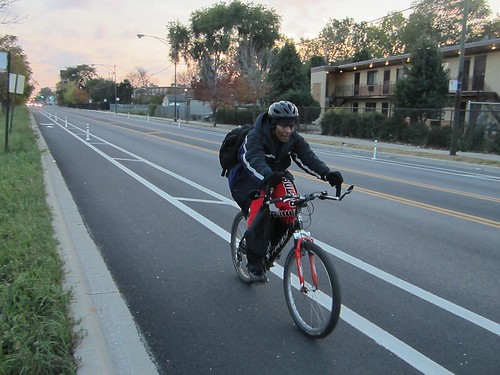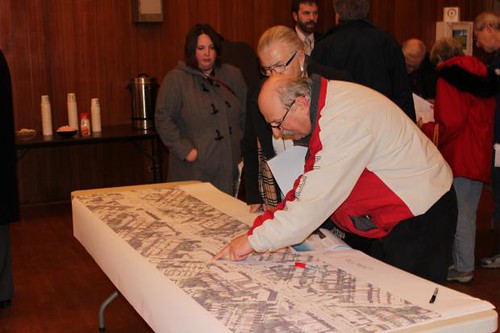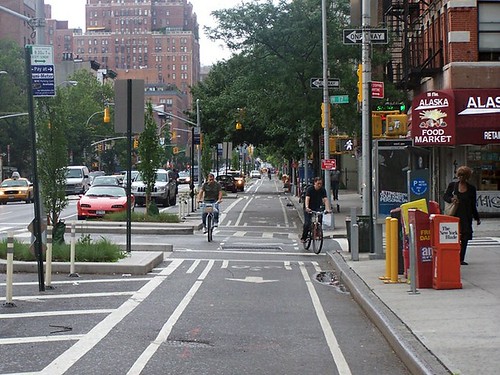View Larger Map
Current conditions at Milwaukee and Manila.
Speaking at an Active Transportation Alliance gala back in 2011, founding director Randy Neufeld predicted that we’d see some major backlash to the mayor’s plan to build 100 miles of protected bike lanes. He asked the audience to see things from the perspective of residents whose streets would be reconfigured, using the metaphor of a stranger coming in and rehabbing your kitchen. “You’d ask, ‘Why is this happening, what are you going to do?’” he said. “Change is very hard.”
That resistance to change was evident at a rowdy community meeting last night on the Chicago Department of Transportation's proposal for a road diet and protected bike lanes on two miles of Milwaukee between Lawrence and Elston on the Far Northwest Side. Explanations by CDOT engineers about how the five lane-to-three lane conversion could reduce crashes, make the street safer for walking and biking, and boost retail, were loudly ridiculed and booed by attendees, according to DNAinfo’s Heather Cherone. 45th Ward Alderman John Arena was forced to repeatedly call for order during the presentation, held at St. Tarcicuss Catholic School in Gladstone Park.
Milwaukee north of the Jefferson Park Transit Center is generally a five-lane speedway, with four travel lanes and a turn lane, plus conventional bike lanes or sharrows. According to CDOT, in the last five years there have been 970 crashes on this stretch, including one fatality and 17 serious injuries. The road diet would change the street to two travel lanes and a turn lane, plus PBLs, which could reduce crashes by 30 percent, CDOT’s Nate Roseberry said at the meeting.
Similar road diets on Chicago Streets have already proven successful in reducing speeding. For example, last year the transportation department installed protected lanes on a broad stretch of Vincennes between 103rd and 84th, which often functioned as a de-facto four-lane street and was plagued by dangerous driving and crashes. The project reconfigured the street as two narrow, clearly defined travel lanes and a turn lane, plus the PBLs. After installation, average motor vehicle speeds between 7 and 8 a.m. dropped from 38 mph to 32 mph, the number of speeders was reduced from 624 to 390, and the number of vehicles going over 40 mph dropped from 192 to 54.
However, many people at the Milwaukee meeting said they want to maintain the car-centric status quo. "I like the neighborhood the way it is," said longtime resident Susan Belcastro, drawing cheers and applause from the crowd, Cherone reported. "I like the way Milwaukee opens up after [the transit center.]"
"Traffic flows just fine in this area, and we love it," said Rose Niedorezo, whose family runs Artorium, a private arts center for children in Jefferson Park. "One lane in each direction? I just don't see how that can work."
It’s understandable that neighbors might have concerns about a major change to a local thoroughfare, but the track record of similar redesigns doesn't bear out their fears. Studies have shown that traffic moves just fine on two-lane streets with center turn lanes that see 20,000 or fewer motor vehicles per day, which is consistently the case on this stretch of Milwaukee. The road diet will likely have no negative impact on traffic flow. However, because there is currently too much capacity on Milwaukee north of Lawrence, speeding is encouraged, which results in the high crash rate.
As the engineers pointed out, by calming traffic, the road diet won’t just benefit people on bikes, but also pedestrians, transit users and drivers. The protected lanes will shorten crossing distances for peds, and the project will also include high-visibility, zebra-striped crosswalks, and possibly pedestrian refuge islands. At the meeting, local father Ryan Richter said he supports the reconfiguration because the many travel lanes and high-speed traffic make it dangerous for him to cross from his home to a nearby park with his young daughters.
By making walking and biking safer and more pleasant, the project is also likely to encourage more foot traffic. In other cities where travel lanes were converted to protected bike lanes, retail sales have increased after implementation For example, in 2007 a protected bike lane and pedestrian islands were installed, and a travel lane removed, on Ninth Avenue in Manhattan’s Chelsea neighborhood. Sales increased 49 percent over three years, outpacing both neighboring retail streets and the rest of the borough. However, when Roseberry mentioned this potential benefit, attendees shouted their disbelief and jeered at him.
Residents and merchants also objected to the possible removal of parking spots to improve sight lines for the protected lanes. However, as Richter pointed out in the comments section of the DNA piece, city parking counts show that the vast majority of spaces on this stretch Milwaukee are used less than 50 percent of the time, and no spaces are used more than 85 percent of the time.
Other features of the project could include new pavement, traffic signal coordination to facilitate vehicle flow, and redesigned bus stops that will make it easier to pick up passengers without blocking traffic. An additional community meeting will be held this spring, with construction starting in late 2014 or early 2015, Roseberry said.
As Neufeld said, change can be scary. However, this project to improve safety, livability and commerce along the corridor, which will benefit locals as well as others who travel on Milwaukee, shouldn’t be deep-sixed in order to the maintain current conditions, which are dangerous for all road users.








